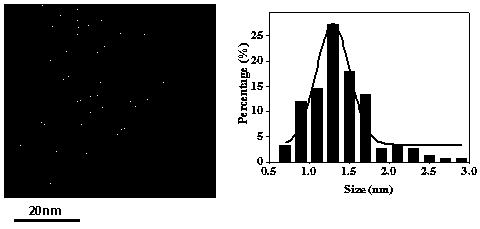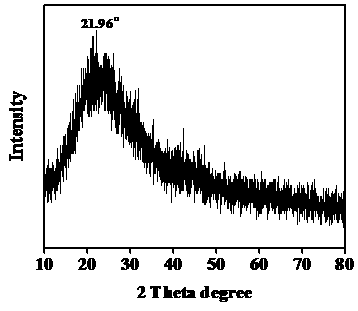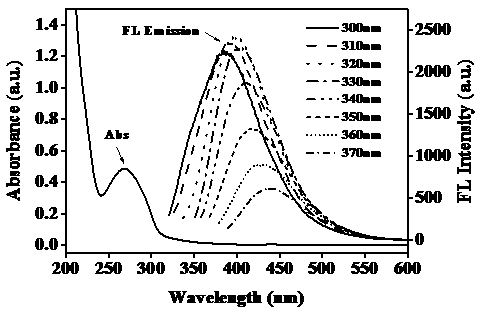Preparation method of carbon nano-particles from mature vinegar
A technology of carbon nanoparticles and fluorescence, applied in nanotechnology, nano-optics, nanotechnology, etc., can solve the problems of harsh preparation conditions, side effects, and long time required for the preparation method, and achieve good fluorescence characteristics and biocompatibility , high safety, good effect
- Summary
- Abstract
- Description
- Claims
- Application Information
AI Technical Summary
Problems solved by technology
Method used
Image
Examples
Embodiment 1
[0025] Example 1 is the preparation method of carbon nanoparticles from mature vinegar. The specific steps are: S1. Rotate about 100mL of mature vinegar at 45°C to about 10mL, filter through 0.45µm and 0.22µm water filter membranes successively, and collect filtrate. Then use a macroporous adsorption resin column to separate and purify, observe under the irradiation of a 365nm ultraviolet lamp, collect strong fluorescent components, and obtain carbon nanoparticle solid powder after freeze-drying; S2, carbon nanoparticle and dopamine hydrochloride with a mass ratio of 15:4 proportions, and dissolved in deionized water. Adjust the pH to 8.5 with Tris, and stir in the dark for 24 hours, add 6 times the volume of isopropanol to the above mixture, remove the precipitate by high-speed centrifugation (10,000rpm, 10min), remove the isopropanol by rotary evaporation, freeze-dry Color-changed carbon nanoparticles are obtained.
Embodiment 2
[0026] Embodiment 2 is the characterization of the properties of carbon nanoparticles in mature vinegar, S1, the morphology and size of carbon nanoparticles in mature vinegar, figure 1 It is a transmission electron microscope photo and a particle size statistical diagram of mature vinegar carbon nanoparticles. The results show that the separated and purified mature vinegar carbon nanoparticles are uniform in size, regular in shape and nearly spherical, and the statistics show that the particle size of mature vinegar carbon nanoparticles is concentrated in the range of 1- 2nm; S2, the X-ray photoelectron diffraction (XRD) experiment of aged vinegar carbon nanoparticles, figure 2 It is the XRD spectrum of carbon nanoparticles in mature vinegar. It can be seen that there is only a steamed bun peak at 2 theta = 21.96°. According to the XRD spectrum, it is shown that the carbon nanoparticles have an amorphous carbon structure; S3, the ultraviolet spectrum and fluorescence spectrum ...
Embodiment 3
[0027] Example 3, for the cytotoxicity experiment, select MCF-7 cells and high-glucose DMEM medium containing 10% fetal bovine serum, add antibiotics and non-essential amino acids, and seed MCF-7 cells in 96 wells with 10,000 cells / well In the plate, after the wall was completely adhered (12h), the original medium was discarded, and the carbon nanoparticles reacted with dopamine were respectively dissolved in the medium, and then diluted with the medium to different concentrations, and added In the above-mentioned 96-well plate, after incubation for 48 hours, the value-added rate was measured by the MTT method, such as Figure 8 As shown, the MCF-7 cell survival rate can still reach more than 70% under the larger concentration (10mg / mL) of mature vinegar carbon nanoparticles, indicating that the toxicity of mature vinegar carbon nanoparticles is low, such as Figure 9 As shown, the toxicity of carbon nanoparticles reacted with dopamine to MCF-7 cells was also low.
PUM
 Login to View More
Login to View More Abstract
Description
Claims
Application Information
 Login to View More
Login to View More - R&D
- Intellectual Property
- Life Sciences
- Materials
- Tech Scout
- Unparalleled Data Quality
- Higher Quality Content
- 60% Fewer Hallucinations
Browse by: Latest US Patents, China's latest patents, Technical Efficacy Thesaurus, Application Domain, Technology Topic, Popular Technical Reports.
© 2025 PatSnap. All rights reserved.Legal|Privacy policy|Modern Slavery Act Transparency Statement|Sitemap|About US| Contact US: help@patsnap.com



